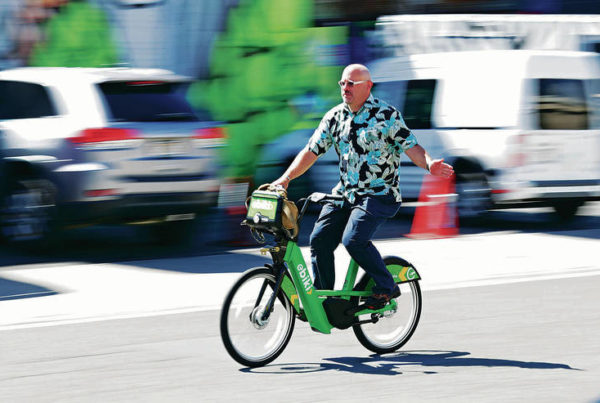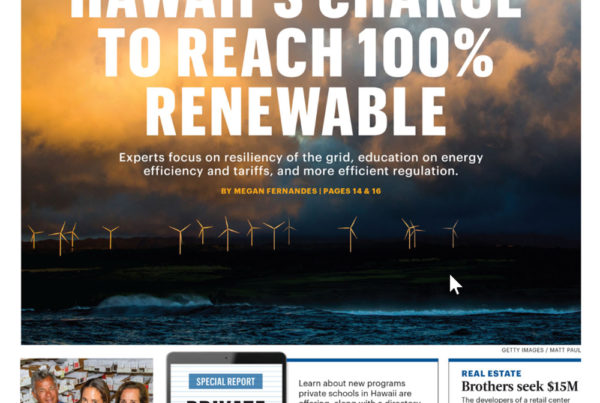Pacific Business News
May 9, 2019
by EUGENE TANNER
 Dozens of teal bikes tagged with maintenance receipts lined the Biki garage, as three bicycle mechanics tinkered to repair, maintain and clean the “Sad Biki” bikes to conform to standards and be re-deployed into the Biki fleet. At the same time, adjacent to the property, a man scans a card at the pay station and rides off on a Biki, pedaling along Ala Moana Boulevard. The moving parts behind the scenes have helped the Honolulu-based bicyclesharing service, Biki, grow rapidly and earn a claim to fame on a national level.
Dozens of teal bikes tagged with maintenance receipts lined the Biki garage, as three bicycle mechanics tinkered to repair, maintain and clean the “Sad Biki” bikes to conform to standards and be re-deployed into the Biki fleet. At the same time, adjacent to the property, a man scans a card at the pay station and rides off on a Biki, pedaling along Ala Moana Boulevard. The moving parts behind the scenes have helped the Honolulu-based bicyclesharing service, Biki, grow rapidly and earn a claim to fame on a national level.
Biki has been named the sixth most-used bikeshare program in the nation, despite being the youngest program to top the list. The National Association of City Transportation Officials released a report that ranked programs and found more than twice as many trips — 84 million — were taken through bikeshare and scootershare programs in the U.S. as compared to the year before.
“With Biki, Honolulu developed a convenient, reliable service that meets the mobility needs of its users,” Nicole Payne, program manager at NACTO, said. “This is reflected in the wide popularity of what is now one of the country’s largest bikeshare systems, a feat Biki reached in only its second year of operation.”
Biki competed against longstanding bikeshare programs in the top five metropolitan cities of New York, Chicago, Washington, D.C., the San Francisco Bay Area and Boston, all of which were established between 2010 to 2017.
Biki was launched by nonprofit Bikeshare Hawaii on June 28, 2017, though planning and funding for the program began years before the first bikes were docked downtown.
“Honolulu is punching above its weight in BikeShare,” said Todd Boulanger, executive director of Bikeshare Hawaii. “Honolulu is perfect because of its good urban form, how we’ve laid out the systems by convenience, spacing and sizing of stations and because of the community support. We’ve been able to plan out a system that is very useful. The total investment in our system, in capital and operations, only equals about 10 city buses.”
Milestones along the way
Biki’s most recent expansion elevated the fleet from 1,000 bikes to just under 1,300 bikes and increased its stations from 100 to 130.
According to Boulanger, the stations with the highest Biki rental traffic are in Waikiki, Kakaako and downtown. The system-wide average is three rides per Biki per day, but in the higher-demand stations, that number can go up to seven rides per Biki per day.
Through Biki’s data, Boulanger is finding that there is a trend of downtown workers using Biki to get to work.
“We don’t expect our members to Biki in from Ewa,” he said. “A lot of customers park their cars in cheap parking spaces they rent or are provided by employers and then Biki to meetings, to lunch and other errands, because they have found that it’s quicker to Biki than un-park your car, look and pay for a parking space and then come back and re-park your car after.”
For work or play
Since data and community response show that residents want to utilize Biki to get around downtown, Biki is also now marketing toward businesses to include a private Biki dock at their building.
“Employers can sign their staff up as a way to get around to meetings or to job sites,” Boulanger said. “We have an employer plan, where we can enroll their staff and we will come up with a discounted plan for them. It’s big for employers who want to promote a healthy commute for its employees.”
Boulanger said that investing in a Biki station at the workplace is cost-and-space effective.
“Most businesses can’t afford to build parking structures,” he said. “For the entire investment cost, private and public for Biki, you might be able to build a 100-car parking structure, which can serve a small shopping plaza. But we are serving the entire city center for that price. That is where it becomes additive, a finer mesh that supports buses, walking and the HART rail.”
The benefits also extend to businesses that are anchored near a public station.
“Businesses want to be near Biki stops,” Boulanger said. “When the customer docks their bike there, they look around and say, ‘oh, there’s a coffee shop right here’ or ‘oh, I’m hungry, there’s a restaurant.’”
Boulanger calls local restaurants and and coffee shops “the fuel for Biki.” This is why he plans on partnering with businesses to roll out new features on the Biki mobile app to map out restaurants and coffee shops near each docking station.
The cost behind Biki
Since Biki operates under the nonprofit Bikeshare Hawaii, Biki’s revenue from operations does not go to it. It instead goes to the private operator Secure, which raised more than $4 million for the first phase of rolling out equipment. Other investments came from city and county seed money.
“They’re still paying off original debt for the bikes,” Boulanger said as he explained the farebox recovery dilemma in transit systems. “Most transit systems don’t make a profit. It’s a mix of member revenue, which is subsidized by either sponsorships, donations or venture capital.”
Currently Bikeshare Hawaii has three employees who run the nonprofit and 10 operations, mechanics and service center employees. Sponsorships cover staff costs.
“At some point there will be profit sharing, but that will be in many years,” he said.
According to Boulanger, the biggest hurdle facing Biki is the amount of time it takes to add public stations, which can take anywhere from six months to a year to make it a reality.
Safety first
Biki is a portmanteau word, a combination of the words bike and the Hawaiian word for fast: wikiwiki. The blended name is also a double entendre, as Biki does emphasize safety to its riders and recommends coming into its office for safety demonstrations. All bikes are equipped with daytime running lights, LED lights on the front and back, and twist-shift gears.
“Biki’s bikes are generally more well maintained and safer than most private bicycles on the streets of Honolulu,” Boulanger said. “Safety is important because a lot of drivers here, until recently, didn’t have a lot of experience sharing the road with cyclists.”
Compared to the other bikes in the study, Biki was the first city to pick the Public Bike System’s Fit model of the bike, which is about 10 pounds lighter and two inches lower than the Iconic model bike that Chicago and New York use, according to Boulanger.
“It’s especially important for novice cyclists and the elderly, so they have more control and a lower center of gravity,” he said.
The right momentum
Biki has seen new leadership changes recently. Boulanger took over six months ago to replace Lori McCarney, who announced her departure from the organization in June 2018.
“Right when I started, we went through the expansion and new round of sponsorships,” Boulanger said. “We’ve moved from the start-up phase to the institutionalizing phase. We work with the city on permits and work with developers so new buildings that come in will have a spot for Biki. It’s working to normalize it.”
He said his main job is continuing and furthering Biki’s ridership, but that has not come without both ups and downs along the way.
“We built a lot of stations that were too small when we first went in,” Boulanger said. “We tried to make the initial entry into the community less shocking, because it’s a big change … We found that sometimes those stations are just too small. The smaller the station, the more often we have to send the vans in to rebalance the docking stations. That can be a bigger negative to businesses with more traffic or members who may have to wait.”
Each car stall of 20 feet can hold eight docks and similar to LEGO bricks, stations can be stacked upon easily to any size.
“Private property owners are starting to embrace us,” Boulanger said. “Prince Waikiki and Queen Kapiolani Hotel recently hosted a station. We are looking into Kamehameha Schools and the Ala Moana Center.”
Other bikeshare programs on the Mainland have not seen as much support as Biki has. Back in 2016 and 2017, Portland’s Biketown bikeshare locations were vandalized soon after its initial launch, with tires slashed and spokes cut. Boulanger said that the engagement with the community through back-and-forth dialogue has helped shape Biki’s bikeshare system into what the community wants and needs.
Boulanger said that developing Biki’s layout was conceived through the public process of asking: ‘What should bikeshare look like, what should it serve, what should be its priorities?’
“We haven’t had the same kind of rash vandalism that Portland has seen in the past because the community fully embraced it here,” he said. “I used to ask, if the weather is always so good here, why don’t people ride more in Downtown Honolulu? The biggest barriers were people didn’t maintain their bikes or they had no place to store it … With the bikeway network, it’s getting easier for people to choose a bike for their trip.”
Payne summarized what is working especially well for Biki: It has a large number of closely spaced stations, conveniently placed where people want to go.
“Biki’s innovative fare structure makes the system easy to access for all types of users, and cities have looked to Biki as a model for growing their own bikeshare systems across the country,” Payne said. “As bikeshare continues to make gains as a convenient mobility option for short trips, we look forward to the continued evolution of Biki’s system in serving [Honolulu residents.]”
Geared up for the future
The future of Biki lies partially in the convenience of Biki’s mobile app, which is filled with black-and-blue markers that show the current supply and occupancy of a docking location. New features are still in the development phase.
“If a station is empty, you can place a bike there but you know not to go there to pick one up,” Boulanger said. “We place stations close enough together to give people a plan B.”
Boulanger said that what will truly take Biki to the next level is Honolulu’s finished protective bike network.
“There are some mauka and makai routes, like on Ward Avenue and Piikoi Street, they are funded and designed but we need them built so cyclists can have equal access like they do along the King Street bikeway. This would be mauka-to-makai access.”
Bikeshare Hawaii is also in the planning phases with the city to map out potential routes going into Iwilei, Kalihi-Palama, Kaimuki, and the possibility of electrifying the entire system.
“If we were to electrify them, like New York City, they see as many as 15 uses per day per electric bike,” Boulanger said. “In essence, we could triple the use of our bikes if we electrify them. That has additional hardware and operating costs, but the use can intensify.”
In 2018, 65 percent of riders were members and 35 percent were a single riders, which Boulanger said are likely tourists. Other refinements to the system include working on a low-income fare and redesigning the entire fare structure as a whole, which will be rolled out the summer of its third year.
“The goal is making the system efficient, electrifying the fleet, expanding with the rail when it makes sense, working with Neighbor Islands on if they are going to have a bikeshare system, making the system sustainable and making Bikeshare last.”
In 2017, only six months after Biki launched its fleet, it was named the eighth- most used bikeshare in the nation, by the same NACTO study done a year before.
“We are up there with the top dogs,” he said. “We’re in a sweet spot here.”






